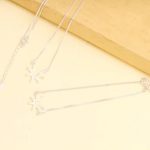The history of David Andersen jewelry is a fascinating journey through the evolution of artistic craftsmanship and design. For over 140 years, David Andersen has been synonymous with exquisite, high-quality jewelry that captures the essence of Norwegian heritage and innovation. From its humble beginnings to becoming a renowned name in the industry, the story of David Andersen jewelry is one of creativity, passion, and enduring legacy.
The life and career of David Andersen himself played a significant role in shaping the brand’s identity. His early experiences and artistic influences laid the foundation for what would become a hallmark of Scandinavian design. The founding of David Andersen Jewelry Company marked the beginning of a legacy that continues to thrive today, as his innovative designs continue to captivate jewelry enthusiasts worldwide.
From the influence of Art Nouveau and Art Deco on his creations to his signature techniques and designs, every aspect of David Andersen’s work reflects a commitment to excellence and an unwavering dedication to craftsmanship. As we delve into the evolution and expansion of David Andersen Jewelry, we uncover how each piece tells a story that transcends time, making it a timeless treasure for generations to come.
Early Life and Career of David Andersen
The early life and career of David Andersen played a significant role in shaping the renowned jewelry brand that bears his name. Born in 1843 in Bergen, Norway, Andersen showed an early aptitude for design and craftsmanship. His passion for art and jewelry led him to pursue formal training as a goldsmith and silversmith, first in Norway and later in Germany.
Training and Influences
Andersen’s time in Germany exposed him to a diverse range of artistic influences, including the intricacies of Jugendstil (German Art Nouveau) and the geometric designs of the Wiener Werkstätte (Vienna Workshops). These experiences would ultimately inform his own unique style and approach to jewelry making.
Establishing His Reputation
Upon returning to Norway, Andersen set up his own workshop in Oslo, where he began creating distinctive pieces that garnered attention for their exceptional craftsmanship and innovative designs. He quickly gained a reputation for his attention to detail, use of bold colors, and incorporation of traditional Norwegian motifs into his work. This early success laid the foundation for what would become one of the most influential jewelry brands in Europe.
Influence on Norwegian Jewelry
David Andersen’s early career coincided with a period of cultural awakening in Norway, as artists sought to express national identity through their creations. As such, Andersen’s work not only reflected current trends in international design but also contributed significantly to the development of a distinctly Norwegian style within the broader context of European jewelry making. This influence continues to be felt in contemporary Scandinavian jewelry design.
The Founding of David Andersen Jewelry Company
In the early 19th century, Norwegian silversmith David Andersen set out to establish his own jewelry company, which would become synonymous with quality and craftsmanship. After completing his apprenticeship in Copenhagen, Denmark, Andersen returned to Norway and opened his workshop in Oslo in 1876. This marked the beginning of what would eventually become one of the most renowned jewelry companies in Europe.
With a commitment to creating exceptional pieces that reflected the trends of the time while also incorporating traditional Norwegian craftsmanship, David Andersen quickly gained recognition for his innovative designs and meticulous attention to detail. His work became highly sought after not only in Norway but also throughout Europe.
The founding of David Andersen Jewelry Company was not just a business venture for Andersen; it was a reflection of his passion for preserving and promoting Norwegian heritage through exquisite jewelry-making. His dedication to incorporating traditional Norse motifs into his designs while also embracing modern influences set the stage for the brand’s success and longevity.
Throughout its long history, the company has remained committed to upholding these values and continues to thrive as a testament to David Andersen’s vision and legacy.
The Influence of Art Nouveau and Art Deco on David Andersen Jewelry
The influence of Art Nouveau and Art Deco on the jewelry created by David Andersen is a key factor in the success and enduring legacy of the brand. Both art movements had a profound impact on the designs of David Andersen, shaping the aesthetic and style of the jewelry produced by the company.
Art Nouveau Influence
Art Nouveau was a major source of inspiration for David Andersen’s jewelry designs. Characterized by its use of organic and natural forms, such as flowers, plants, and flowing lines, this art movement had a significant impact on the artistic direction of David Andersen’s work. The incorporation of enamel work in intricate patterns and vibrant colors was a hallmark feature of many pieces produced during this time.
Art Deco Influence
Following the Art Nouveau period, the emergence of Art Deco also left its mark on David Andersen jewelry. The emphasis on geometric shapes, strong lines, and bold colors influenced the design direction of the brand during this era. As a result, pieces from this time often featured sleek and streamlined forms, with an emphasis on symmetry and precision.
The fusion of these two influential art movements within David Andersen’s designs resulted in a unique and distinctive aesthetic that continues to be celebrated today. The history of David Andersen jewelry is deeply intertwined with the principles and styles championed by Art Nouveau and Art Deco, showcasing their enduring influence on the brand’s creations throughout its rich history.
David Andersen’s Signature Techniques and Designs
David Andersen’s jewelry is renowned for its exquisite craftsmanship and unique designs, which have been a hallmark of the brand since its inception. The techniques and designs used by David Andersen have set his jewelry apart and contributed to the brand’s enduring legacy in the industry.
Here are some of David Andersen’s signature techniques and designs:
1. Enamel Work: One of the defining features of David Andersen jewelry is the use of vibrant and intricate enamel work. This technique involves fusing powdered glass onto metal surfaces, creating colorful and detailed designs. The use of enamel has become synonymous with David Andersen jewelry, adding a luxurious and distinctive touch to each piece.
2. Filigree Detailing: Another hallmark of David Andersen’s jewelry is the use of filigree detailing. This delicate and intricate metalwork involves twisting and curling fine metal wires to create ornate patterns and motifs. The filigree detailing seen in David Andersen pieces reflects a high level of craftsmanship and attention to detail.
3. Scandinavian Inspired Designs: Drawing inspiration from his Norwegian heritage, David Andersen incorporated Scandinavian themes into his designs. Nature motifs such as leaves, flowers, and animals were frequently featured in his jewelry, reflecting a connection to the natural world that remains an integral part of the brand’s identity.
These signature techniques and designs have not only distinguished David Andersen jewelry but have also influenced trends in the industry for decades. The brand’s commitment to quality craftsmanship and innovative design continues to attract collectors and enthusiasts seeking timeless pieces with a touch of artistic flair.
The Evolution and Expansion of David Andersen Jewelry
David Andersen Jewelry has seen a remarkable evolution and expansion since its founding in the late 19th century. From its humble beginnings as a small workshop in Oslo, Norway, the brand has grown into an internationally recognized name in the world of jewelry. Here are some key points to consider when looking at the evolution and expansion of David Andersen Jewelry:
- International Presence: Over the years, David Andersen Jewelry has successfully expanded its presence beyond Norway to reach customers around the globe. With flagship stores in major cities and a strong online presence, the brand has made its mark on the international market.
- Diversification of Products: While initially known for its exquisite enamelwork, David Andersen Jewelry has diversified its product range over time. From traditional pieces to modern designs, the brand offers a wide range of jewelry to cater to different tastes and preferences.
- Innovative Techniques: Throughout its history, David Andersen Jewelry has been at the forefront of innovation in jewelry making. The brand has incorporated new techniques and materials into its designs, ensuring that it remains relevant and appealing to modern consumers.
The history of David Andersen Jewelry is not just a story of growth, but also one of adaptation and innovation. The brand’s ability to evolve with the times while staying true to its artistic roots has been essential in establishing it as a leader in the industry.
As we delve into the evolution and expansion of David Andersen Jewelry, it becomes clear that this iconic brand continues to influence and inspire modern jewelry makers around the world. Its enduring legacy serves as a testament to the timeless appeal of quality craftsmanship and innovative design.
Notable Collections and Collaborations
Over the years, David Andersen Jewelry has gained recognition for its unique and innovative collections, as well as its collaborations with prominent artists and designers. One of the most notable collections by David Andersen is the “Cityscape” collection, which features intricate designs inspired by urban landscapes. This collection showcases the brand’s commitment to craftsmanship and attention to detail, reflecting the influence of art deco on David Andersen’s work.
In addition to its in-house designs, David Andersen Jewelry has also collaborated with renowned artists and designers, such as Norwegian sculptor Jette Friis and architect Thorolf Holmboe. These collaborations have resulted in stunning pieces that blend traditional craftsmanship with modern aesthetics, further solidifying David Andersen’s reputation as a pioneer in the jewelry industry.
Furthermore, David Andersen Jewelry has been featured in prestigious exhibitions and museums around the world, including the Victoria and Albert Museum in London and the Metropolitan Museum of Art in New York. This global recognition highlights the lasting impact of David Andersen’s creations and his contributions to the art of jewelry making.
| Collection/Collaboration | Significance |
|---|---|
| Cityscape Collection | Reflects influence of art deco on David Andersen’s work |
| Jette Friis Collaboration | Showcases fusion of traditional craftsmanship with modern aesthetics |
| Museum Features | Recognition in Victoria and Albert Museum & Metropolitan Museum of Art |
Through its notable collections and collaborations, David Andersen Jewelry continues to be a significant presence in the world of fine jewelry, maintaining a legacy that spans generations. The brand’s ability to adapt to changing styles while staying true to its artistic roots exemplifies its enduring appeal among collectors and connoisseurs alike.
David Andersen Jewelry Today
David Andersen Jewelry has continued to maintain its legacy and influence in the industry, remaining a prominent name in the world of art jewelry. The company has upheld its reputation for producing high-quality pieces with exquisite craftsmanship, capturing the essence of both traditional and modern design elements. With a rich history spanning over 140 years, David Andersen Jewelry has successfully adapted to changing trends while preserving its signature style.
One of the key factors contributing to the enduring success of David Andersen Jewelry is its commitment to innovation and creativity. The company has continuously introduced new designs and techniques, often drawing inspiration from nature, mythology, and historical motifs. By staying true to its artistic roots while embracing contemporary influences, David Andersen Jewelry has remained relevant in an ever-evolving market.
In addition to its dedication to craftsmanship and design, David Andersen Jewelry has also expanded its global reach through strategic collaborations with renowned artists and designers. These partnerships have allowed the brand to introduce exclusive collections that appeal to diverse audiences, further solidifying its position as a powerhouse in the jewelry industry.
| Aspect | Data |
|---|---|
| Years in operation | Over 140 years |
| Influence on market | Prominent name in art jewelry |
| Global reach | Strategic collaborations with renowned artists and designers |
Conclusion
In conclusion, the history of David Andersen Jewelry is a true testament to the enduring legacy and influence of this iconic brand in the jewelry industry. From its humble beginnings in Norway to its global recognition, David Andersen’s innovative designs and techniques have left an indelible mark on the world of jewelry.
The early life and career of David Andersen laid the foundation for his eponymous jewelry company, and his passion for art and design became the driving force behind the brand’s success. With a keen understanding of Art Nouveau and Art Deco styles, David Andersen was able to create timeless pieces that captured the essence of these influential movements while infusing them with his own distinctive flair.
Throughout its evolution and expansion, David Andersen Jewelry has continued to uphold its reputation for excellence and precision craftsmanship. Notable collections and collaborations have further solidified the brand’s standing as a leader in the industry, attracting collectors and enthusiasts alike.
Today, David Andersen Jewelry remains a revered name synonymous with quality, creativity, and sophistication. The legacy of David Andersen lives on through its timeless designs, continuing to inspire new generations of artisans and admirers. As we look back on the remarkable history of David Andersen Jewelry, it is clear that this is a brand that will continue to shape the future of jewelry design for years to come.
Frequently Asked Questions
Who Is the Famous Norwegian Silversmith?
The famous Norwegian silversmith is David-Andersen, known for his high-quality silver jewelry and decorative items. His work has gained international recognition and his name is synonymous with Norwegian silver craftsmanship.
When Was Silver First Used for Jewelry?
Silver has been used for jewelry since ancient times, with evidence of its use dating back as far as 3000 BC in Mesopotamia. Throughout history, various cultures have valued silver for its beauty and rarity, using it to create intricate and valuable pieces of jewelry.
Why Is Silver Used for Jewellery?
Silver is used for jewelry due to its lustrous appearance, malleability, and durability. It is a versatile metal that can be easily shaped into intricate designs, making it ideal for creating detailed and ornate jewelry pieces.
Additionally, silver’s affordability compared to other precious metals makes it a popular choice for both fine and fashion jewelry. Its ability to complement a wide range of gemstones also adds to its appeal in the world of jewelry design.

Welcome to my jewelry blog! My name is Sarah and I am the owner of this blog.
I love making jewelry and sharing my creations with others.
So whether you’re someone who loves wearing jewelry yourself or simply enjoys learning about it, be sure to check out my blog for insightful posts on everything related to this exciting topic!





